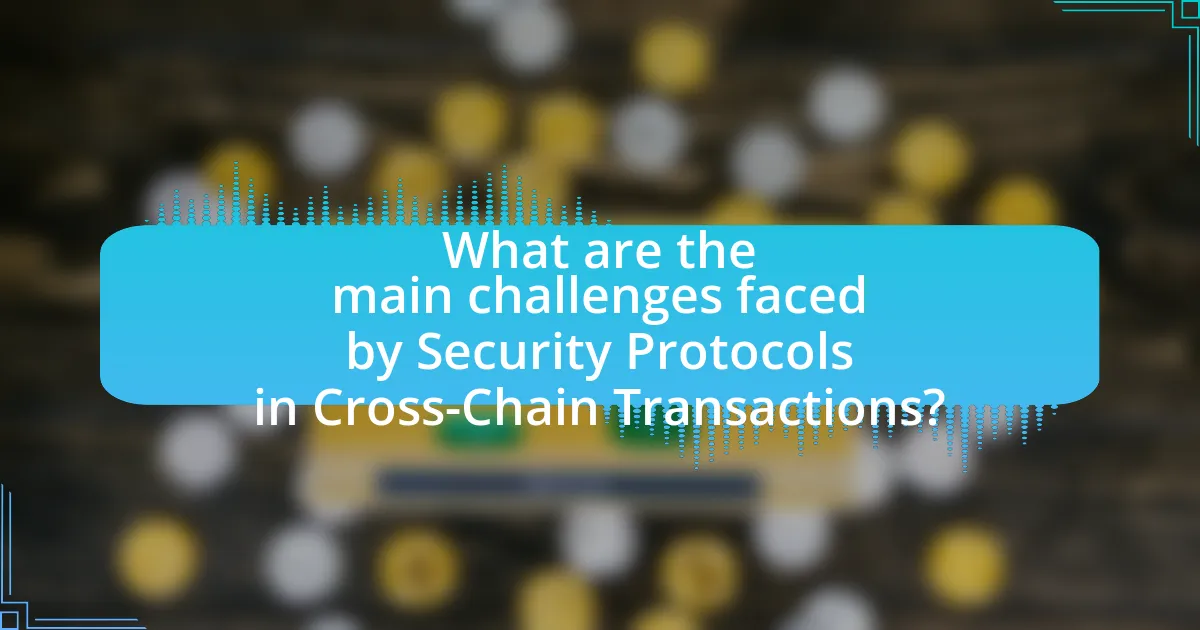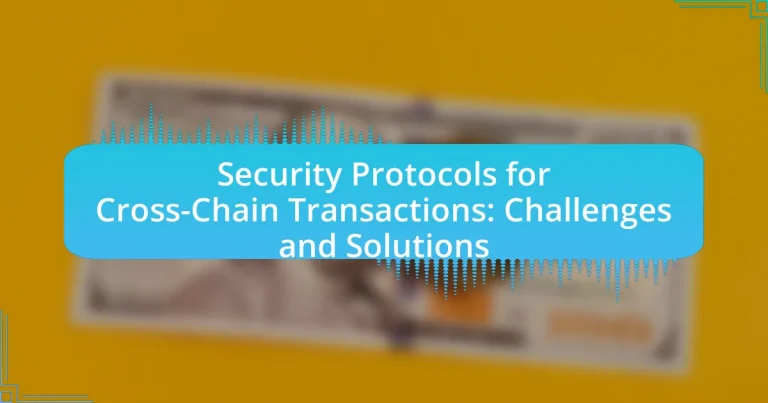Security protocols for cross-chain transactions are essential mechanisms that ensure the integrity, confidentiality, and authenticity of data exchanged between different blockchain networks. This article explores the various security protocols, such as atomic swaps and interoperability standards like the Inter-Blockchain Communication (IBC) protocol, which facilitate secure asset exchanges. It also addresses the key components of these protocols, including authentication, encryption, and consensus mechanisms, while highlighting the risks associated with cross-chain transactions, such as double spending and unauthorized access. Furthermore, the article discusses the challenges faced by security protocols, including interoperability issues and regulatory compliance, and presents solutions to enhance security, such as decentralized oracles and multi-signature wallets.

What are Security Protocols for Cross-Chain Transactions?
Security protocols for cross-chain transactions are mechanisms designed to ensure the integrity, confidentiality, and authenticity of data exchanged between different blockchain networks. These protocols typically include atomic swaps, which allow for the direct exchange of assets across chains without intermediaries, and interoperability standards like the Inter-Blockchain Communication (IBC) protocol, which facilitates secure communication between blockchains. Additionally, security measures such as multi-signature wallets and decentralized oracles are employed to verify transactions and prevent fraud. The effectiveness of these protocols is supported by their ability to mitigate risks associated with cross-chain interactions, such as double spending and transaction replay attacks.
How do Security Protocols function in Cross-Chain Transactions?
Security protocols in cross-chain transactions function by ensuring secure communication and data integrity between different blockchain networks. These protocols utilize cryptographic techniques, such as hashing and digital signatures, to authenticate transactions and verify the legitimacy of the assets being transferred. For instance, atomic swaps allow for the exchange of assets across chains without the need for a trusted intermediary, relying on smart contracts to enforce the terms of the transaction. Additionally, interoperability protocols like Polkadot and Cosmos facilitate secure cross-chain interactions by establishing a shared security model, which enhances trust and reduces the risk of fraud. These mechanisms collectively address the challenges of security and trust in cross-chain transactions, ensuring that assets are transferred safely and efficiently.
What are the key components of Security Protocols in this context?
The key components of security protocols for cross-chain transactions include authentication, encryption, integrity verification, and consensus mechanisms. Authentication ensures that only authorized entities can initiate transactions, while encryption protects data during transmission, preventing unauthorized access. Integrity verification confirms that the data has not been altered during the transaction process. Consensus mechanisms facilitate agreement among multiple blockchain networks, ensuring that all parties acknowledge and validate the transaction. These components collectively enhance the security and reliability of cross-chain transactions, addressing the inherent challenges of interoperability between different blockchain systems.
How do these components interact to ensure security?
The components of security protocols for cross-chain transactions interact through a combination of cryptographic techniques, consensus mechanisms, and interoperability standards to ensure secure data exchange and transaction integrity. Cryptographic techniques, such as hashing and digital signatures, provide authentication and data integrity, ensuring that transactions are verified and tamper-proof. Consensus mechanisms, like proof of work or proof of stake, facilitate agreement among participating blockchains, preventing double-spending and ensuring that all nodes have a consistent view of the transaction history. Interoperability standards, such as atomic swaps or cross-chain bridges, enable seamless communication between different blockchain networks, allowing for secure and efficient transaction execution across diverse platforms. Together, these components create a robust framework that mitigates risks associated with cross-chain transactions, such as fraud and data breaches.
Why are Security Protocols essential for Cross-Chain Transactions?
Security protocols are essential for cross-chain transactions because they ensure the integrity, confidentiality, and authenticity of data exchanged between different blockchain networks. These protocols mitigate risks such as double spending, unauthorized access, and data tampering, which can occur when assets are transferred across disparate systems. For instance, the use of cryptographic techniques in security protocols helps to validate transactions and secure communication channels, thereby preventing malicious attacks. Additionally, the implementation of standards like the Interledger Protocol facilitates secure interoperability between blockchains, enhancing trust and reliability in cross-chain operations.
What risks are associated with Cross-Chain Transactions?
Cross-chain transactions are associated with several risks, including security vulnerabilities, interoperability issues, and transaction finality concerns. Security vulnerabilities arise from the complexity of integrating different blockchain protocols, which can lead to potential exploits, such as double-spending or unauthorized access. Interoperability issues occur when different blockchains have incompatible protocols or standards, making it difficult to execute transactions seamlessly. Additionally, transaction finality concerns can arise due to the varying consensus mechanisms across blockchains, leading to uncertainty about whether a transaction has been successfully completed. These risks highlight the challenges in ensuring secure and reliable cross-chain transactions.
How do Security Protocols mitigate these risks?
Security protocols mitigate risks in cross-chain transactions by implementing encryption, authentication, and consensus mechanisms. These protocols ensure that data integrity is maintained, unauthorized access is prevented, and transactions are verified across different blockchain networks. For instance, protocols like Atomic Swaps utilize cryptographic techniques to enable secure exchanges without the need for intermediaries, thereby reducing the risk of fraud. Additionally, the use of multi-signature wallets enhances security by requiring multiple approvals for transactions, further safeguarding against unauthorized actions.

What are the main challenges faced by Security Protocols in Cross-Chain Transactions?
The main challenges faced by security protocols in cross-chain transactions include interoperability issues, security vulnerabilities, and consensus discrepancies. Interoperability issues arise because different blockchain networks often use distinct protocols and standards, making seamless communication difficult. Security vulnerabilities can occur due to the complexity of bridging multiple chains, which may expose transactions to attacks such as double-spending or replay attacks. Consensus discrepancies happen when different blockchains have varying methods for validating transactions, leading to potential conflicts and inconsistencies in transaction finality. These challenges highlight the need for robust security measures and standardized protocols to ensure safe and efficient cross-chain transactions.
What technical challenges impact the effectiveness of Security Protocols?
Technical challenges that impact the effectiveness of security protocols include interoperability issues, scalability limitations, and vulnerabilities to attacks. Interoperability challenges arise when different blockchain networks use varying protocols, making it difficult for security measures to function seamlessly across chains. Scalability limitations hinder the ability of security protocols to handle a high volume of transactions efficiently, which can lead to delays and increased risk of breaches. Additionally, vulnerabilities to attacks, such as Sybil attacks or replay attacks, can compromise the integrity of security protocols, as evidenced by incidents in blockchain history where such weaknesses were exploited, leading to significant financial losses.
How do interoperability issues affect Security Protocols?
Interoperability issues significantly undermine the effectiveness of security protocols by creating vulnerabilities during cross-chain transactions. When different blockchain networks lack standardized communication methods, security protocols may fail to authenticate or validate transactions accurately, leading to potential exploits. For instance, a study by Zohar et al. (2020) highlights that discrepancies in consensus mechanisms between chains can result in unauthorized access or double-spending attacks. Furthermore, without seamless interoperability, the complexity of integrating various security measures increases, making it easier for malicious actors to identify and exploit weaknesses. Thus, interoperability challenges directly compromise the integrity and reliability of security protocols in cross-chain environments.
What role does scalability play in these challenges?
Scalability significantly impacts the challenges faced in security protocols for cross-chain transactions. As the volume of transactions increases, the ability of security protocols to efficiently process and validate these transactions becomes critical. For instance, if a protocol cannot scale effectively, it may lead to increased latency and potential vulnerabilities, as slower processing times can expose the system to attacks. Research indicates that blockchain networks like Ethereum have faced congestion issues, resulting in higher transaction fees and slower confirmation times, which directly affect the security and reliability of cross-chain transactions. Thus, scalability is essential for maintaining robust security in the face of growing transaction demands.
What regulatory and compliance challenges exist for Security Protocols?
Regulatory and compliance challenges for security protocols primarily involve the need to adhere to varying international laws and standards, which can differ significantly across jurisdictions. For instance, the General Data Protection Regulation (GDPR) in Europe imposes strict data protection requirements that security protocols must comply with when handling personal data. Additionally, the Financial Action Task Force (FATF) guidelines require that security protocols implement measures to prevent money laundering and terrorist financing, which can complicate cross-chain transactions. These challenges are compounded by the rapid evolution of technology, making it difficult for existing regulations to keep pace, leading to potential legal ambiguities and compliance risks for organizations implementing security protocols in cross-chain environments.
How do varying regulations across jurisdictions complicate Security Protocols?
Varying regulations across jurisdictions complicate security protocols by creating inconsistencies in compliance requirements. Different regions may mandate distinct data protection laws, reporting standards, and security measures, leading to challenges in implementing uniform security protocols. For instance, the General Data Protection Regulation (GDPR) in the European Union imposes strict data handling requirements, while the United States has a more fragmented regulatory landscape with laws like the California Consumer Privacy Act (CCPA). These discrepancies necessitate tailored security measures for each jurisdiction, increasing operational complexity and the risk of non-compliance.
What are the implications of non-compliance for Cross-Chain Transactions?
Non-compliance in cross-chain transactions can lead to significant security vulnerabilities and financial losses. When protocols are not adhered to, the integrity of the transaction process is compromised, increasing the risk of fraud, double spending, and unauthorized access to assets. For instance, a lack of standardized security measures can result in inconsistent validation processes across different blockchain networks, making it easier for malicious actors to exploit weaknesses. Additionally, non-compliance can lead to regulatory penalties and loss of trust among users, as seen in cases where platforms failed to meet compliance standards, resulting in legal actions and reputational damage.

What solutions are available to enhance Security Protocols for Cross-Chain Transactions?
To enhance security protocols for cross-chain transactions, solutions include the implementation of atomic swaps, multi-signature wallets, and decentralized oracles. Atomic swaps allow for direct peer-to-peer exchanges between different blockchains without the need for intermediaries, reducing the risk of fraud. Multi-signature wallets require multiple private keys to authorize a transaction, adding an extra layer of security against unauthorized access. Decentralized oracles provide reliable data feeds between blockchains, ensuring that transactions are executed based on accurate and verified information. These solutions collectively address vulnerabilities inherent in cross-chain interactions, thereby improving overall security.
How can technological advancements improve Security Protocols?
Technological advancements can improve security protocols by enhancing encryption methods, implementing artificial intelligence for threat detection, and utilizing blockchain technology for transparency and integrity. Enhanced encryption methods, such as quantum encryption, provide stronger protection against unauthorized access, making it significantly harder for attackers to breach systems. Artificial intelligence can analyze vast amounts of data in real-time to identify anomalies and potential threats, thereby enabling proactive security measures. Furthermore, blockchain technology ensures that all transactions are recorded in a tamper-proof manner, which increases accountability and reduces the risk of fraud. These advancements collectively contribute to more robust and resilient security protocols, addressing the challenges faced in cross-chain transactions.
What role do cryptographic techniques play in enhancing security?
Cryptographic techniques play a crucial role in enhancing security by providing mechanisms for data confidentiality, integrity, and authentication. These techniques, such as encryption and hashing, ensure that sensitive information remains protected from unauthorized access and tampering. For instance, symmetric and asymmetric encryption algorithms, like AES and RSA, are widely used to secure data in transit and at rest, making it difficult for attackers to decipher the information without the appropriate keys. Additionally, hashing functions, such as SHA-256, verify data integrity by producing a unique hash value for the original data, allowing any alterations to be easily detected. The implementation of these cryptographic methods is essential in securing cross-chain transactions, as they help establish trust between different blockchain networks and protect against potential vulnerabilities.
How can decentralized solutions address existing challenges?
Decentralized solutions can address existing challenges by enhancing security, transparency, and efficiency in cross-chain transactions. These solutions eliminate single points of failure, reducing the risk of hacks and fraud, as evidenced by the increased security seen in decentralized finance (DeFi) platforms, which have reported fewer breaches compared to centralized counterparts. Furthermore, decentralized protocols enable trustless interactions between different blockchain networks, facilitating seamless transactions without the need for intermediaries. This is supported by the rise of interoperability protocols, such as Polkadot and Cosmos, which allow diverse blockchains to communicate securely and efficiently. Thus, decentralized solutions provide a robust framework for overcoming the inherent vulnerabilities and inefficiencies present in traditional transaction systems.
What best practices should be adopted for implementing Security Protocols?
To implement effective security protocols, organizations should adopt a multi-layered approach that includes encryption, access controls, regular audits, and incident response plans. Encryption protects data integrity and confidentiality during cross-chain transactions, while access controls ensure that only authorized users can interact with sensitive information. Regular audits help identify vulnerabilities and ensure compliance with security standards, and incident response plans prepare organizations to quickly address security breaches. According to the National Institute of Standards and Technology (NIST), implementing these practices significantly reduces the risk of data breaches and enhances overall security posture.
How can organizations ensure compliance with Security Protocols?
Organizations can ensure compliance with security protocols by implementing a comprehensive framework that includes regular audits, employee training, and adherence to industry standards. Regular audits help identify vulnerabilities and ensure that security measures are effectively enforced, while employee training fosters awareness and understanding of security protocols. Adhering to industry standards, such as ISO/IEC 27001, provides a structured approach to managing sensitive information and demonstrates a commitment to security best practices. These measures collectively enhance an organization’s ability to maintain compliance with security protocols.
What strategies can be employed to educate users about security risks?
To educate users about security risks, organizations can implement comprehensive training programs that include interactive workshops, online courses, and regular security awareness campaigns. These programs should focus on real-world scenarios, such as phishing attacks and data breaches, to illustrate potential threats. Research indicates that organizations with ongoing security training see a 70% reduction in security incidents, highlighting the effectiveness of such educational strategies. Additionally, providing users with clear guidelines and resources, such as infographics and checklists, can reinforce learning and promote best practices in security awareness.
What are the future trends in Security Protocols for Cross-Chain Transactions?
Future trends in security protocols for cross-chain transactions include the adoption of decentralized identity solutions, enhanced cryptographic techniques, and interoperability standards. Decentralized identity solutions aim to provide secure and verifiable identities across multiple blockchains, reducing the risk of fraud. Enhanced cryptographic techniques, such as zero-knowledge proofs, will enable secure transactions without revealing sensitive information, thereby improving privacy. Additionally, the development of interoperability standards, like the Interledger Protocol, will facilitate seamless communication between different blockchain networks, ensuring secure and efficient cross-chain transactions. These trends are driven by the increasing demand for secure, scalable, and user-friendly cross-chain solutions in the evolving blockchain ecosystem.
How might emerging technologies shape the future of Security Protocols?
Emerging technologies will significantly enhance the future of security protocols by introducing advanced encryption methods, decentralized identity solutions, and artificial intelligence-driven threat detection. These technologies enable more robust protection against cyber threats, as seen with quantum encryption, which offers theoretically unbreakable security by leveraging the principles of quantum mechanics. Additionally, decentralized identity frameworks, such as those based on blockchain, provide users with greater control over their personal data, reducing the risk of identity theft. AI-driven systems can analyze vast amounts of data in real-time to identify and respond to potential security breaches more effectively than traditional methods. The integration of these technologies is crucial for addressing the evolving challenges of cross-chain transactions, where security protocols must adapt to diverse blockchain environments and potential vulnerabilities.
What role will community governance play in the evolution of these protocols?
Community governance will play a crucial role in the evolution of security protocols for cross-chain transactions by enabling decentralized decision-making and fostering collaboration among stakeholders. This governance model allows participants to propose, discuss, and vote on protocol changes, ensuring that the protocols evolve in a manner that reflects the needs and priorities of the community. For instance, successful implementations of community governance can be observed in projects like Ethereum, where community input has led to significant upgrades and improvements, such as the transition to Ethereum 2.0. This participatory approach not only enhances the adaptability of security protocols but also builds trust among users, as they have a direct influence on the protocol’s development and security measures.
What practical steps can organizations take to enhance Security Protocols for Cross-Chain Transactions?
Organizations can enhance security protocols for cross-chain transactions by implementing multi-signature wallets, which require multiple approvals for transaction execution, thereby reducing the risk of unauthorized access. Additionally, they should adopt robust encryption methods to protect data integrity during transfers between different blockchain networks. Regular security audits and vulnerability assessments can identify potential weaknesses in the system, allowing organizations to address them proactively. Furthermore, utilizing decentralized oracles can ensure accurate data feeds across chains, minimizing the risk of manipulation. Finally, establishing clear governance frameworks and compliance measures can help organizations maintain security standards and respond effectively to emerging threats.

















